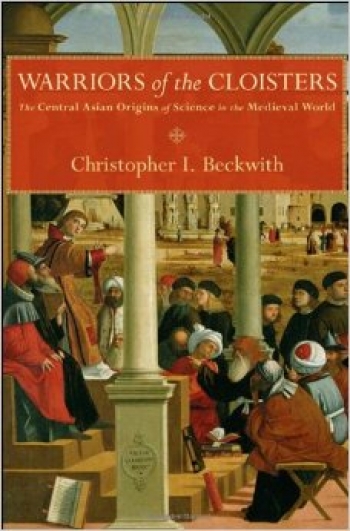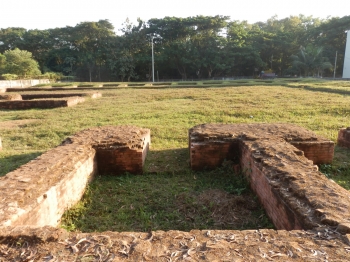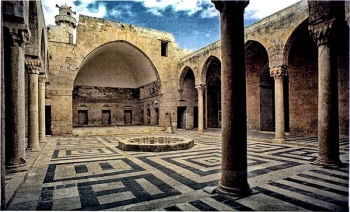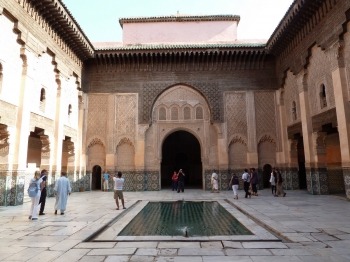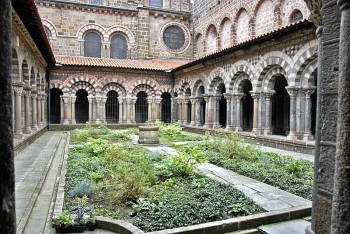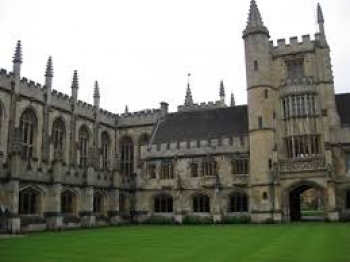Christopher Beckwith robustly argues in Warriors of the Cloisters that modern science, or as he calls it, a “full scientific culture,” which took root in the Scientific Revolution of the Enlightenment, is not an independently arisen European construct but, rather, owes its origins to a series of transmissions. This line of transmissions runs from the Buddhists of Central Asia via Islam of the Classical Arabic Civilization to medieval Latin Europe. A full scientific culture could only be firmly established after the two cornerstones of Beckwith’s argument—the “recursive argument method” used in scientific discourse and the institution of the college—had been developed. According to Beckwith, the college finds its antecedents in the Islamic madrasa and the Buddhist vihara.
Beckwith considers the recursive argument to be “the basic vehicle for the analysis of problems in natural philosophy and theology from the medieval [13th-century] intellectual revolution to the scientific revolution” (p. 1). The structure of a text using the recursive argument is as follows: T:W(1),X(1),Y(1),Z(1) : A : W(2),X(2),Y(2),Z(2). T is the TOPIC, A is the AUTHOR’S VIEW ARGUMENT, and W, X, Y, and Z are the SUBARGUMENTS. The Topic is followed usually by a series of SUBARGUMENTS (1) in which various views are presented for consideration and debate. This first list of subarguments is followed by SUBARGUMENTS (2), presented in the same order, as a response to SUBARGUMENTS (1) in the form of clear-cut answers. Finally comes the AUTHOR’S VIEW ARGUMENT, which may appear in different places within the structure, to conclude the topic. The author then moves on to the next topic and repeats the process.
The origin of the recursive argument has long been considered to have been in Europe, an extension of an earlier European tradition independent of developments elsewhere. Beckwith resolutely counters this perception by presenting a counter-argument he never allows his readers to ignore: he posits that the earliest textual evidence in Latin can only be traced back to the early 13th century, and not before.
To find the origins of the recursive argument, we need to navigate a series of transmissions stretching back several centuries earlier to Buddhist Central Asia, where there is evidence of an earlier form of the recursive argument (p. 56). Beckwith states that the Ashtagrantha (1st century BCE) is the earliest text to show a primitive version of the recursive argument, in which each topic is followed by a long list of arguments about the topic that are repeated and debated one by one in sequential order. The Vibhasha of the Bactrian-Gandharan branch of the Sarvastivada school in the 1st century CE, during the Kushan empire, is the earliest example of a more mature recursive argument: it reveals the use of numbers—a special feature of the recursive argument—although only the first list of subarguments is numbered, with the items in the second list repeated in summary form without numbers. Other examples of the recursive argument in Central Asian Buddhist texts cited by Beckwith are the Vibhasha of Sitapani (translated by Suryabhadra in 383), the Mahavibhasha (150 CE) of Kashmir (translated from Sanskrit to Chinese by Buddhavarman from 437–39 and by Xuanzang from 656–59), and Vasubandhu’s Abhidharmakosha-bhashya (4th or 5th century CE).
Despite a lack of sources on the transmission of the recursive argument from the Buddhists of Central Asia to the succeeding Muslims and the Classical Arabic Civilization, Beckwith still finds evidence of the recursive argument in the works of some Islamic scholars from the region. One example is Avicenna (980–1037), who used it in two of his early works, Metaphysics (c. 1000–10) and Maqala fi’l-Nafs (L. De anima; E. On the soul; 1014–20), as well as in his Kitab al-Shifa (E. Book of healing; 1020). Other Islamic scholars and theologians who used the recursive argument include Al-Ghazali (1058–1111), Al-Farabi (872–950), and Averroes (1126–1198).
Islam passed on what it learned from the ancient Greeks and Central Asia to medieval Latin Europe through the great translations done in southern Spain—the works of Aristotle, classical Arabic works on Aristotelian natural science, Indian mathematics—and what was of crucial importance for Beckwith, the recursive argument and the college from Central Asia. Beckwith asserts that the recursive argument and the college were not integrated into Islamic culture, however, being mostly used for religious purposes.
Upon the arrival of these two new developments in Latin Europe, they began to be used in both religion and science. The recursive argument in Latin appeared 100 years after classical Arabic learning was translated and introduced to medieval Latin Europe. Thomas Aquinas, Roger Bacon, and Peter of Poitiers all took advantage of the recursive argument in their works. The complete integration of the recursive argument and the college into medieval Latin culture would lead ultimately to the development of a full scientific culture (p. 8).
I find Beckwith’s argument for linking the vihara, madrasa, and college less convincing. He argues that they have the same form, function, teaching program, and legal structure—but is this a completely accurate representation? Architecturally, all three do have the same form and structure. Viharas and madrasas have a rectangular plan with a quadrangle of one or two floors of arcaded hallways opening onto a central courtyard. Behind the arcades are cells for resident students. At the center of each side of the quadrangle, Islamic architects added a large half-domed space (A. iwan) with the open side facing the courtyard. This architectural form is carried over to the cloisters in monasteries and colleges in Europe. Again, there is a rectangular building with arcaded vaulted passages surrounding an open courtyard. In colleges, there are doors in the vaulted passages leading to rooms for masters and students.
While the function of the madrasa and college is as a recognizably institutionalized place of learning, is this the same for all Buddhist viharas? I have my reservations. Viharas were originally built by rich lay patrons as a residence for monks during the three-month Rains period when they are supposed to gather in one place rather than wander around. This requirement was further laid out in the Vinaya in response to concerns about monks trampling on insects that come to the surface during the heavy rains. Over time, monks began to live in viharas throughout the year on a more permanent basis as their way of life became more sedentary.
In both Pali and Sanskrit, the noun “vihara” has a verbal form, viharati, meaning “to live, dwell, stay.” Simply stated, the vihara’s function is as a dwelling place, not as a formal, institutionalized place of learning—except for the ancient Buddhist universities or mahaviharas of Nalanda, Takshashila, and Vikramashila—unlike the madrasa and college.
Beckwith believes that the recursive argument and the college led to a “quantum leap” from having a few scientists and some good science (Classical Arabic Civilization) to having a full scientific culture in medieval Europe (p. 147). In his view, both elements come from outside medieval Europe, with Islamic and Buddhist roots in Central Asia.
Beckwith managed to keep my attention and admiration throughout his discussion of the recursive argument and his valiant attempt to bring Central Asia’s contribution into focus. His thesis is thought-provoking, and forces one to take a less Eurocentric viewpoint. This is his strength and contribution. Beckwith leaves the reader in no doubt that scientific culture and Latin Europe owe a great debt for their “. . . existence and lasting success to those distant, much ignored people of Central Asia and their once brilliant civilization” (p. 159).
Warriors of the Cloisters. The Central Asian Origins of Science in the Medieval World was published by Princeton University Press in 2012.
